|
February 2012
Article
AutomatedBuildings.com
|
[an error occurred while processing this directive]
(Click
Message to Learn More)
|
|
Building Technologies to Support Energy Efficient and Sustainable Designs
A key educational component of Cascade Meadow is a
web-based ‘window’ into its infrastructure to illustrate the benefits
of green technologies and to generate thought-provoking ways for
individuals, businesses and organizations to adopt similar sustainable
efforts in their own environments.
|

Marlee Rosen,
Rosen Associates |
Cascade Meadow Wetlands & Environmental Science Center, an
impressive new facility located adjacent to restored upland and wetland
habitats in Rochester, Minnesota, is utilizing a variety of products
from Kepware to gather critical data for environmental education and
management of its ‘green’ facility.
Cascade Meadow intends to be a catalyst for educational activities that
promote sustainable living now and in the future. Cascade Meadow
supports effective and efficient use of water and energy resources in
the southeast Minnesota region and also provides a central location for
exhibits, educational programming and sponsored events.
Cascade Meadow is proud of its sustainable structure and is pursuing
U.S. Green Building Council’s “Leadership in Energy and Environmental
Design” (LEED) certification for its two-level 16,000 square foot
beautifully architected building. Surrounding the building are
extensive restored native landscapes and a sizable pond that provides a
cohesive environment with the building. There are a total of 75
acres of upland and wetland natural habitats in which the Cascade
Meadow organization intends to develop an extensive open trail system
for its visitors.

A key educational component of Cascade Meadow is a web-based ‘window’
into its infrastructure to illustrate the benefits of green
technologies and to generate thought-provoking ways for individuals,
businesses and organizations to adopt similar sustainable efforts in
their own environments.
Cascade Meadow: A Profile for Green
The structure of the main education center was built using some of the
most energy efficient materials available. For instance, many of the
walls were constructed using insulated concrete forms (ICF).
Other walls and roofing were developed using structural insulated
panels (SIPs). There are ‘green’ roofs and special windows that
tint electronically in order to conserve energy.
To provide heating and cooling, the building uses a water source heat
pump and the air handler has built-in energy recovery equipment.
At the site reside a horizontal axis wind turbine, a vertical axis wind
turbine, a solar hot-water system and three photovoltaic solar panels,
each with a specific solar technology for energy efficiencies. PV
station, for example, uses thin film solar cell technology and is
mounted on a rack system that tracks the sun as it moves across the
sky. PV Station 2 also tracks the sun but uses a more common
“polycrystalline” solar cell technology; and PV Station 3 has
polycrystalline solar cells, but rather than tracking the sun, the
array is mounted on a rack that will be adjusted based on the season
(angle of the sun).
Three separate systems are used to monitor and control the building’s processes:
Electrical energy consumption metering system
Electrical energy production system (for renewable resources)
HVAC or building mechanical system
It’s the critical data collected in these three separate systems that
will provide ongoing transparency into the energy efficiency of Cascade
Meadow and which will be available, in real time, to science center
visitors and off-site users via a web interface.
Making the Connection
With three independent management systems, Cascade Meadow was faced
with a significant challenge - how to integrate the data collected from
each of these disparate systems into a single comprehensive
‘dashboard’. The dashboard will be able to provide a consolidated
overview of operations as well as serve as a showcase for the energy
efficiencies generated by Cascade Meadow’s green technologies.
Integrated Technology Engineering, a company also based in Rochester
that has a long history of solving complicated industrial and
automation engineering challenges, was selected for this project
because of its roots in industrial and municipal automation and wide
range of electrical and mechanical engineering services. Cascade
Meadow wanted an experienced integration team that could develop a
flexible application that would be able to integrate the important data
from all three building systems into one location. This data
would then be presented in a dashboard for educational purposes as well
as to manage and control the facilities operations.
Dylan Christopherson, project engineer, led the team that identified
and specified the technology needed to meet the vision set forth by
Cascade directors.
“When the building was designed, a lot of thought was put into the
systems that Cascade wanted to install but there were no specifications
in place for tying all the pieces together seamlessly. For
example, they knew they wanted renewable systems onsite and wanted to
be able to manage them from one central location. They also had a
need to monitor the energy use of the lighting and electrical systems
as well as the building’s HVAC equipment. All three of those
systems were installed by separate contractors with no connectivity
between them. We were brought in to bridge that gap.”

Integrated Technology Engineering choose products from Kepware,
including the KEPServerEX OPC Server v5, Modbus Drivers, BACnet
Drivers and the Datalogger to create a comprehensive informational
environment that meets all the specifications desired by Cascade Meadow.
“We’re using Kepware because it’s the most flexible software that we
know of that could communicate with three different systems and bring
all that information in to one place where we could make it
useful. Kepware is highly flexible and has been used before with
great success,” Dylan adds.
System Profile – Gathering Data
Cascade installed Square D PowerLogic as its electrical use monitoring
system and is connected over Ethernet. The PowerLogic equipment
is capable of a moderate amount of data logging and reporting.
According to Dylan, Cascade uses the PowerLogic Modbus gateway to
communicate directly with the energy monitoring sensors that are
connected on the Modbus loop. Kepware’s Modbus Driver is being
used to communicate with the Square D PowerLogic system to currently
monitor about 10 I/O points. This system monitors and records
electrical usage for three key areas. It is able to determine how
much of the building’s total electrical use is consumed by the
mechanical systems, interior and exterior lighting.
 The Electrical Energy Production system also uses Modbus. The
Integrated Technology Engineering team is using Kepware’s Modbus driver
to communicate with an Obvius AquiSuite controller. “Similar to
the PowerLogic system, we’re not communicating directly with the
controller but using Kepware to ‘talk’ to the Modbus devices that are
on that loop – which includes the horizontal axis wind turbine,
vertical axis turbine, three solar panels and two weather
stations. We’re able to monitor all of these components and
evaluate their performance,” Dylan says.
The Electrical Energy Production system also uses Modbus. The
Integrated Technology Engineering team is using Kepware’s Modbus driver
to communicate with an Obvius AquiSuite controller. “Similar to
the PowerLogic system, we’re not communicating directly with the
controller but using Kepware to ‘talk’ to the Modbus devices that are
on that loop – which includes the horizontal axis wind turbine,
vertical axis turbine, three solar panels and two weather
stations. We’re able to monitor all of these components and
evaluate their performance,” Dylan says.
The Johnson Controls HVAC/Building management system is a stand-alone
system that controls the air handler and heat pumps in order to keep
the building comfortable and properly ventilated. This system
uses Kepware’s BACnet Driver to record some of the available data so
that the performance of the building mechanical systems can be
evaluated.
“We’re able to monitor the temperature of every room in the building
via intelligent thermostats. We can monitor outdoor air temperature as
well as air data in every stage of the air handler, such as return air,
supply air, mixed air temperatures, water temperatures entering and
leaving the coils, and status of the energy recovery wheel.”
Cascade has also installed in-floor radiant heating and with the system
that’s in place, is able to monitor the temperatures of that
system. The energy for the heat pumps comes from a geothermal
loop installed in an onsite pond. “From the BACnet controller, we
have information on how much energy is being pulled from the pond or
how much energy is rejected to the pond. There’s also a solar
panel to heat domestic water, i.e. for hand-washing, showers,
etc. We can monitor how much energy that system is
collecting. All of this information is available via Kepware’s
BACnet driver,” Dylan explains.
Kepware’s DataLogger Key to the Dashboard
[an error occurred while processing this directive]
Kepware’s DataLogger, which easily logs data from an OPC server into
any ODBC-compliant database, is being used to record data into an SQL
database. From that database, Cascade’s user interface designer
is creating the envisioned ‘dashboard’ of the systems within the
facility.
“That dashboard will be used publicly to increase the visibility of
systems that are usually hidden from view and internally to evaluate
the performance of their systems,” Dylan added. “Cascade will
have displays at the site for groups. For example visitors can look
outside at the wind turbines spinning and look back at the dashboard
display and see that they’re generating five kilowatts. Or, the
website can be used for students in an off-site classroom as an
educational tool.
Kepware made getting that data to the database very
straightforward. We’ve got a single solution that we’re using to
integrate three different systems that had no previous connectivity,”
said Dylan.
Installation and Go-live
Within only two weeks Integrated Technology Engineering was able to
initiate communication with all three systems using KEPServerEX v5,
Kepware’s Modbus TCP/IP and BACnet drivers, which are reading all the
information from the various sensors from all three systems and
delivering the information to the DataLogger, which is sending it to a
SQL database.
“Kepware made it easy. Normally, automation systems are designed
around a common framework or protocol. Since that was not
the case at Cascade Meadow, we needed a solution that could handle
anything we threw at it. That’s why we chose Kepware,” Dylan
adds.
What’s next?
With its focus on energy and water resources, Cascade Meadow is
planning to expand their activities to include monitoring variables
like soil temperature, stratification and the water temperature of the
onsite pond. They’ll also be expanding the information systems to
include trending data as well as comparing the benefits of its
energy-efficient technologies with more traditional
alternatives.
Cascade Meadow intends to stay at the forefront of providing its
community with programs to promote ‘environmental literacy’ for the
benefit of today’s residents and future generations.
About the Author
Marlee Rosen is a researcher and freelance writer/editor for Rosen
Associates. She covers the building automation, energy,
manufacturing and security industries.
footer
[an error occurred while processing this directive]
[Click Banner To Learn More]
[Home Page] [The
Automator] [About] [Subscribe
] [Contact
Us]



 The Electrical Energy Production system also uses Modbus. The
Integrated Technology Engineering team is using Kepware’s Modbus driver
to communicate with an Obvius AquiSuite controller. “Similar to
the PowerLogic system, we’re not communicating directly with the
controller but using Kepware to ‘talk’ to the Modbus devices that are
on that loop – which includes the horizontal axis wind turbine,
vertical axis turbine, three solar panels and two weather
stations. We’re able to monitor all of these components and
evaluate their performance,” Dylan says.
The Electrical Energy Production system also uses Modbus. The
Integrated Technology Engineering team is using Kepware’s Modbus driver
to communicate with an Obvius AquiSuite controller. “Similar to
the PowerLogic system, we’re not communicating directly with the
controller but using Kepware to ‘talk’ to the Modbus devices that are
on that loop – which includes the horizontal axis wind turbine,
vertical axis turbine, three solar panels and two weather
stations. We’re able to monitor all of these components and
evaluate their performance,” Dylan says.